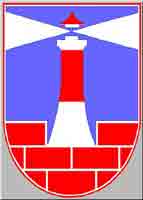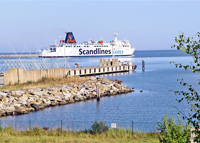Bergen (approx. 15,000 inhabitants) is both the principal town of the district of Ruegen and a traffic junction in the centre of the island. One of the attractions is undoubtedly the Ernst Moritz Arndt Tower, which was built on the Rugard (91m above sea level) in 1886. It is 26.7m high and provides - at good visibility - a wonderful view over the island. It is surrounded by the remains of a fortified wall which temporarily served as a princes' residence.
The city has a long history. The construction of the Marienkirche in Bergen, which is really worth seeing, started already 12 years after the Christianisation of the island's inhabitants. The church was consecrated as a monastery church in 1193 and was also used as a parish church from 1380 onwards. The western exterior wall incorporates a gravestone which assumedly represents a Wendish priest. At the same time, a convent was built in the direct vicinity of the church. It existed until the reformation and - after major constructional changes from 1732 to 1736 - it was converted into a home for female members of the nobility. During the 1990s, comprehensive restoration work started which continues to date. In addition to the city museum, these buildings host a restaurant and several showroom workshops.
Bergen began to replace Garz as administrative centre when Ruegen island and the associated areas on the main land became the property of the Duchy of Pommern-Wolgast after the expiration of the Ruegen dynasty in 1325. However, the site received its town charter only in 1613. It had to pay 800 Talers for it.
Due to the geographical position of the town, until 1891a murky market pond was located in the town centre near the Marienkirche. It constituted simultaneously a cattle watering tank, a fire extinguishing tank - and a nuisance.When the building now used as a post office was built it finally disappeared. The master mason and senator Freese erected the building exactly where the murky puddle had been.
The oldest house of the town and one of the oldest houses on the island is the Benedixhaus on Bergen's market place. ThIS house was built as a timber-framed building after one of the big town fires in 1535, and today it accommodates the tourist information office.
One of the most famous sons of the town is Theodor Billroth. He was one of the most important surgeons of the 19th century and was born in Bergen on 26th April 1829. After studying medicine in Greifswald, Goettingen and Berlin, he was appointed as professor for surgery in Zurich at the age of only 31 years.
Eight years later, he moved to Vienna where he conducted the first successful stomach resection on 29th January 1881. Among his friends one can find "celebrities" like Johannes Brahms. Billroth died on 6th November 1894 in Opatija (Istria/Croatia).
The street in Bergen where his birthplace is located is now called Billrothstrasse.
Photo at the right: Blooming canola fields near Bergen. R.R.
The Town of Putbus, located in the South of the island, was founded in 1810 by Fürst Wilhelm Malte von Putbus. It received its town charter only in 1960. On the 11.08.1955, the first telegraph station of the island of Ruegen was erected at Putbus. On the 15.08.1889 it was connected to the island's railway system via the 10-km-long railway Bergen - Putbus. On the 22.07.1895, the narrow-gauge railway (Rasender Roland), running between Putbus and Binz, was established (1896: continuation to Sellin, 1899 expansion of the line to Goehren). In 1896, the narrow-gauge railway Putbus - Altefaehr opened (it was shut down in 1967). Since 1997, Putbus (2600 inhabitants, including the districts Lauterbach, Neuendorf, Wreechen etc. - about 5000 inhabitants) with its classicistic town centre has a state-approved place for recreation and leisure. The former Earls of Putbus originated from Stoislav, a brother of Ruegen's Earl Jaromar I. The Ruegen-based part the family became extinct in 1702. In 1727, Emperor Karl VI. ennobled the Danish baron Malte I. to the status of a German State Earl; in 1807 he became a Swedish Earl, too.
In 1854, this lineage also died off and the leadership was passed over to a grandson, the Earl Wylich of Lottum.
Putbus has a number of sights, including the Friedrich-Wilhelm-Bath (Bathing house Goor) which was built in 1818. At that time, the town was both a spa deluxe and a meeting place of the nobility and other persons of high rank (King Friedrich Wilhelm IV., Alexander von Humboldt, the King of Denmark etc.) Another noteworthy place is the theatre, the only one on the island, which was build from 1819 to 1821, following designs by W. Steinbachs. It is the only one on the island and was extensively restored between 1992 and 1998.
Based on designs by Schinkel, the castle of Putbus was rebuilt between 1825-32 and renovated after a fire in 1865. Unfortunately, because of many years of neglect it had to be destroyed in 1962.
The palace garden with its rare trees and a small zoo, covering a total size of 75 hectars, is surely worth a visit. You can find here an orangery which was built in 1824 and used as a green house until 1945. Nowadays it serves as an exhibiton centre). The royal stables were built in 1824 as riding and horse stables and are now used for cultural events. Finally, the kursaal was built in 1846 and rebuilt into a church in 1891/92.
The pedagogium which was established in 1833 and passed to the Prussian state as "pedagogium regium" in 1836 is worthwhile mentioning, too. From 1946 to 1975, teachers were trained here, afterwards it accommodated a school for deaf children. Currently, it is an IT-College. R.R.


The town of Sassnitz emerged from the neighbouring places Sassnitz (fishing villages in the East) and Crampas (peasant village in the West). The census of 1767 lists 41 inhabitants in Crampas and 77 in Sassnitz respectively. First tourists who came to enjoy the sea were registered in 1824. However, this source of income only slowly developed. In 1857, for example, 200 guests chose to visit Sassnitz while merely 5 wend to Crampas for their summer holiday.
The real transformation of both villages into spas began in 1860. Over the following years, hotels, guest houses, one ladies' bath at the "Schwanenstein" (today's Molenfuss) and a gentlemen's bath near "Klein Helgoland" (both shut down in 1912) were established as well as the "Waldhalle" located between Sassnitz and the Koenigsstuhl cliff. On the 24.07.1883, the church Johanniskirche was inauguated after a 3-year construction period. The attractiveness of the spa grew further. While 2680 spa guests came to Crampas and 5522 to Sassnitz in 1890, this figure tripled until 1913 to 26585 in total. Even the German empress and her children cam as spa guests to Sassnitz in 1890. The construction of the desperately needed harbour began in 1889. It had become indispensable for fishery, chalk transportation and passenger traffic. A breakwater wall that is 1430 metres long servd for both protection and as a landmark (1889-1896). The railway line from Bergen to Sassnitz, completed in 1891, fitted perfectly into these positive developments. Already in 1861, the first excursion boats of the shipping company "Braeunlich" from Szczeczin landed at Sassnitz . But only after the completion of Sassnitz's harbour the benefits of an active shipping traffic along Ruegen's coast, towards the island of Usedom and to Stettin became obvious and were further extended. Consequently, at the 11th July in 1897 a new post steamer line Sassnitz - Trelleborg replaced the line Stralsund - Malmoe. This line was to be operated in a more efficient way. The international railway connection Sassnitz - Trelleborg was inaugurated in 1909 with lots of pomp as it turned this coastal town of Ruegen into the "Gate to Scandinavia". Prior to this event, a sensible but not generally welcomed innovation occurred in 1906. Crampas and Sassnitz were united into one municipality called Sassnitz. Thus, the village Crampas can no longer be be found on current maps.
Ruegen's chalk industry is ntrinsically tied to Sassnitz. In 1928, 500 000 tons of chalk from Jasmund's chalk pits were loaded and shipped at the Martinshafen (at the Großen Jasmunder Bodden) and in Sassnitz.
After the Second World War, the fish state factory was built. It had a large and capable fishing fleet and a fish processing hall that became independent after 1957. A new chalk factory started its operation in Klementelvitz near Sassnitz in 1963 where it is still prodcucing this vital industry resource.
The number of inhabitants increased from 5000 in 1931 to 14374 in 1985. Sassnitz received its town charter in 1957. For political and economic reasons a completely new ferry port was built in 1982 at a place near Neumukran (nowadays ferry port Sassnitz). Four years later, the first ferry Sassnitz/Mukran - Klaipeda (Memel) landed there. Even if bathing is plays no longer a decisive role in Sassnitz, tourists from all over the world are still attracted to the town harbour and the nearby national park Jasmund with its marvellous beech groves, that is located nearby, as well as the impressive chalk cliffs, the lake Herthasee and the Koenigsstuhl.
Photos and text: R.R.
Garz, formerly a town of smallholding farmers in the south east of Ruegen, is the oldest and with approx. 1800 inhabitants also the smallest town on the island. Garz was raised to city by Duke Wizlaw III in 1316/17.
The town charter of Stralsund was issued in Garz in 1234. The remains of the former duke'S residence "Charenza" can still be seen today, as one of the castle wall was preserved.
After conquering Arkona, the Danes destroyed both a heathen temple located in Garz and the castle in 1168. From 1896 onwards, Garz was connected to the railway system on the island. The railway was, however, removed after 1945. Ernst Moritz Arndt is most likely the most famous son of the town, and the university in Greifswald was named after him.
The village Gross Schoritz (housing Arndt's birthplace) belongs now to the city of Garz.
Arndt was christened and confirmed in the protestant St. Peter's church (which was first built in the middle of the 14th century).
Ernst Moritz Arndt was the son of an emancipated serf who had managed to become a prosperous farmer. The son Ernst Moritz became famous as a writer, author and politician. His best known songs include: "Der Gott der Eisen wachsen ließ" ("The God who let the iron grow ") and "Was ist des Teutschen Vaterland?" ("What is the German's homeland ?"). Arndt studied history and theology and was later appointed a chair of history at the university of Greifswald (later also in Bonn).
He struggled successfully for the abolishment of serfdom in Western Pomerania which was at this point under Swedish rule. During the period of the French occupation, he issued a pamphlet calling on countrymen to revolt against Napoleon. As a result of this publication he had to take refuge in Sweden. Arndt was an enthusiastic fighter for Germany.
He was an advocate of a German national state under Prussian leadership. Being a victim of the so-called prosecution of demagogues, he was dismissed from his office in Bonn (but was rehabilitated later on). Arndt was a member of the Frankfurt National Assembly. He died in Bonn in 1860.